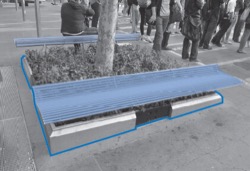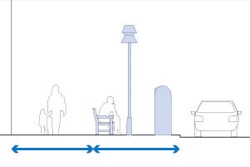On this page:
What are objects in the public realm?
Objects in the public realm include those items located in streets and public spaces that are either for public use and convenience, or for utilities infrastructure and services.
Objects include:
- street furniture
- service cabinets
- trees and planting
- barriers and fencing
- lighting
- signs
- small public buildings and structures.
Some objects for people to use are:
- seats
- drinking fountains
- post boxes
- payphone cabinets
- kiosks
- public toilets.
Some objects enhance the amenity and safety of a space, such as trees, lighting, barriers and signage. Other objects, such as service cabinets, power and telecom poles are not directly used by the public although they are located within the public realm.
Why is it important?
Many public bodies, agencies, and service providers install and manage street furniture and utilities infrastructure. Locating objects in the public realm can affect the accessibility, functionality and safety of a place.
The location, design and management of objects in a public space, can support street function, complement existing activities and contribute to a sense of place. Poorly located objects can contribute to diminished safety and physical and visual clutter.
These guidelines introduce general principles for the placement, integration, form and management of objects in the public realm.
6.1.1: ensure that objects in the public realm support safety and amenity
- Place only the necessary objects in public spaces.
Tip: while placing service cabinets and other objects in public spaces can appear an easy option, the accumulation of many objects can detract from the safety and amenity of a place.
- Where practical, combine or co-locate two or more street furniture functions into a single object.

Tip: to minimise clutter, a tree guard may also provide support for a seat or bicycle parking post, a lighting pole may also support telecommunications. - Place all objects outside main pedestrian or bicycle travel paths and away from street corners.

Tip: when placing objects, avoid creating concealment opportunities, collision or tripping hazards or blocking critical sightlines. - Place all objects outside view lines to significant landmarks and cultural elements.
- Where practical, conceal services infrastructure objects within landscaping or adjacent building.
- Allocate space for temporary objects such as on-street shop displays, cafe tables, vendor stalls, advertising boards, temporary barriers and signs.
6.1.2: ensure objects in the public realm that are robust and easy to maintain
- Develop a simple, standardised palette of materials and designs for street furniture and objects.
Tip: where objects have a simple design and use a minimal palette, people rather than the object provide visual richness.
- Use resilient materials that are easily cleaned, maintained and repaired or recycled.
Tip: quality materials are durable and maintain their appearance over time.
- Develop and use local design standards for furniture, objects and materials.
Tip: design standards for furniture and materials facilitate maintenance, repairs and replacement.
- Conduct periodic reviews of street furniture for changes in use patterns and performance
- Develop and implement an area-wide public art strategy.
Tip: public art is not an expedient to fill an available corner or space; each artwork has its place and purpose. Placement and selection should be guided by a precinct or council-wide plan or strategy.
Page last updated: 09/06/23